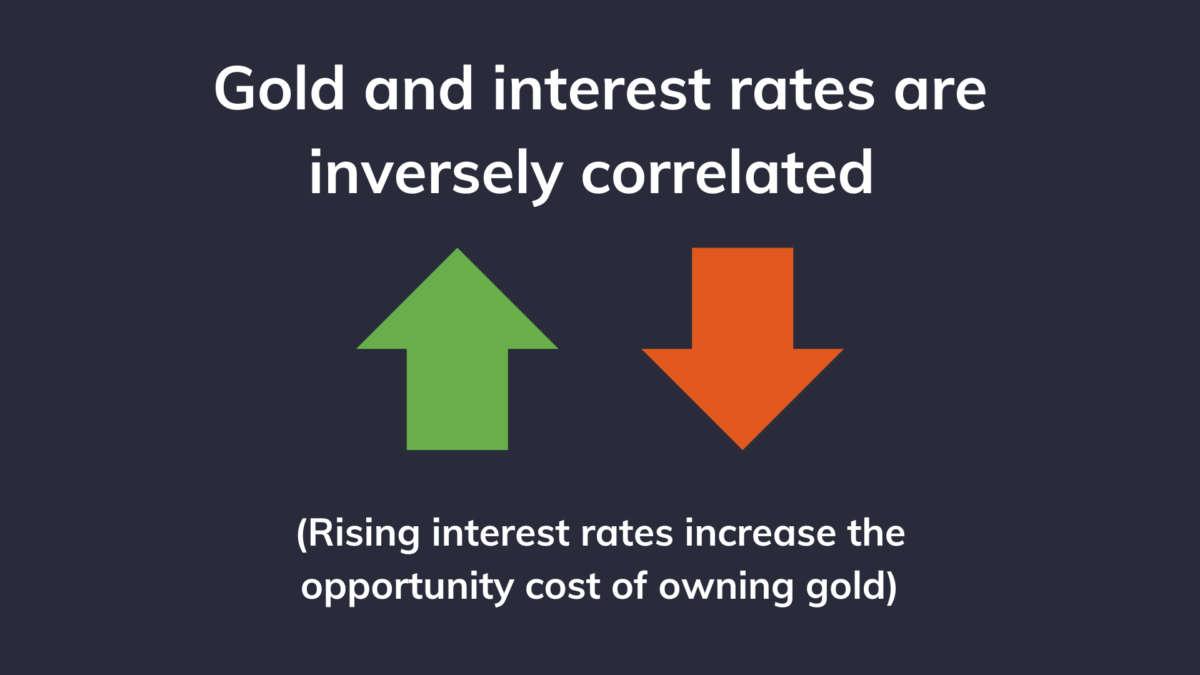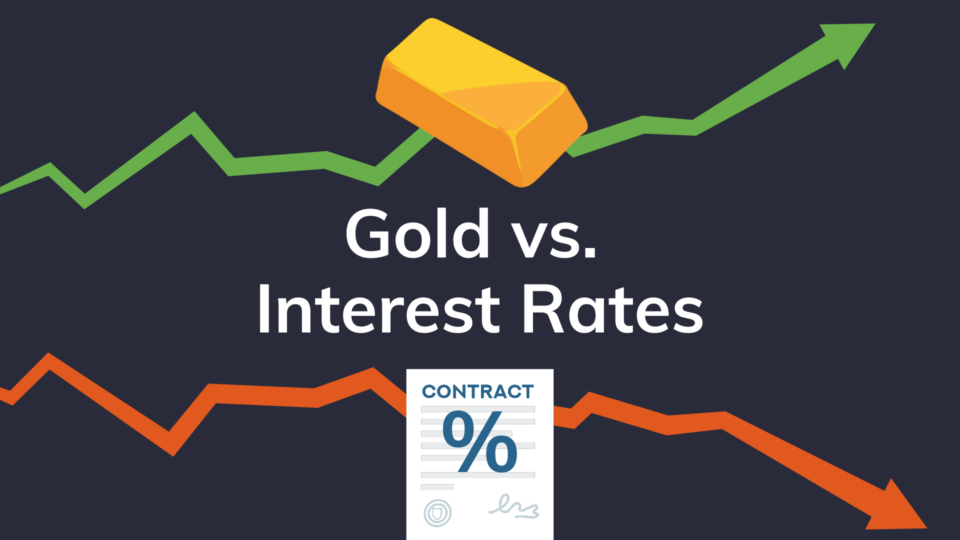Gold and interest rates have an inverse relationship. When interest rates fall, the price of gold tends to rise, and vice versa.
Interest rates vs. gold
When interest rates fall, people tend to buy gold. When interest rates rise, people tend to sell gold. This occurs for three reasons:
1. Interest rates impact the opportunity cost of owning gold
Gold is a non-yielding asset, meaning it doesn’t generate interest income like bonds or savings accounts. When interest rates rise, the opportunity cost of holding gold increases because investors can earn better returns elsewhere. When rates fall, gold becomes more attractive, driving more marginal buyers into the market.
For this reason, gold demand is inversely correlated with yields.
Imagine an investor saying:
- “I know I can earn a 2% yield on my savings this year, but I think the price of gold will rise by 4%. I’m going to buy gold.”
- “However, if yields rise to 5%, I’m going to sell my gold and put my money back into savings.”
2. Lower interest rates mean a larger money supply
The Fed reduces interest rates by increasing the money supply. When the Fed incentivizes commercial banks to lend, the total supply of loanable funds increases, therefore driving down borrowing costs (interest rates).
Over time, the price of gold tends to track the growth in the money supply. We perceive this as a rising gold price, but really it represents the depreciation of fiat currency. As the money supply grows, gold becomes more appealing due to its fixed, limited supply.
3. Interest rates impact the U.S. dollar
Interest rates directly affect the strength of the U.S. dollar. When U.S. rates increase, the dollar typically strengthens against foreign currencies (because foreign investors acquire dollars so they can buy higher-yielding U.S. assets).
Since gold is priced in dollars on major commodity markets, a stronger dollar makes gold more expensive for foreign buyers. When the dollar strengthens, gold demand falls.
Lower interest rates have the opposite effect, weakening the dollar and often boosting gold prices.

Real interest rates matter
In gold investing, real interest rates are more important than nominal interest rates. To calculate the real interest rate, we subtract the rate of inflation from the nominal rate.
If nominal interest rates are high but inflation is also high, the real return on interest-bearing assets is low. In such an environment, gold becomes more attractive as an inflation hedge. When real interest rates are low or negative, gold tends to perform well.
Interest rates are only one of many factors that influence gold. For a more detailed look at all the key factors, check out this article: What makes the gold price rise and fall?
Here is an example of gold’s negative correlation with the real yield on the 10-year treasury:
Why do interest rates move up and down?
An interest rate is the annual cost of borrowing money from a lender, expressed as a % of the total loan amount. Interest rates are often called the “price of time” because when you borrow money, you must pay for the privilege of having it now rather than waiting until you save it yourself. Similarly, when you lend money (or buy a bond), you earn interest for allowing someone else to use your money for a period of time. In both cases, interest compensates for the time involved in lending or borrowing.
Interest rates move up and down due to marginal supply and demand, just like any other price. When the economy has a large supply of loanable funds (because people are saving rather than spending), lending will be more competitive, therefore pushing interest rates lower.
On the other hand, when demand for borrowing outweighs the supply of loans, interest rates will rise.
Ok, so where does the Fed come in?
How does the Fed impact interest rates?
We often hear that the Fed “raised interest rates” or “cut interest rates.” This isn’t exactly correct.
The Fed would have trouble forcing lenders to lend or borrowers to borrow at specific interest rates. It can, however, buy/sell bonds to manipulate the supply of and demand for loans, which impacts interest rates.
When buying bonds, the Fed creates new money and credits it to whatever bank is selling the bond. The effect is twofold:
- The newly created money increases the money supply.
- Buying bonds creates demand that would have not otherwise been present in the market, therefore lowering marginal interest rates.
When the Fed committee meets every six weeks, they set a target range for the Fed Funds Rate, the rate at which commercial banks lend to each other. Economists at the Fed then use their monetary policy tools to manipulate the money supply and buy/sell government bonds to bring prevailing interest rates in line with their target.
Why the Fed adjusts interest rates
If inflation is high, the Fed raises their target interest rate. Higher interest rates make borrowing money more expensive, thus discouraging consumers and businesses from borrowing. This ultimately reduces spending and puts downward pressure on asset prices.
If the economy slows down and unemployment begins to rise, the Fed will lower their target interest rate. This incentivizes consumers and businesses to borrow, spend, and bid up asset prices.
How will the next Fed meeting impact gold?
FOMC meetings always get markets moving.
However, the interest rate decision will only significantly impact gold prices if it deviates substantially from market expectations. In the weeks leading up to the meeting, traders and investors will bid the price of gold higher/lower based on their expectations of what the Fed will do. By the time the Fed meeting rolls around, the decision will be almost entirely “priced in.”
That is, unless the Fed does something unexpected. If the Fed raises rates more than expected (or keeps them steady when the market expects a cut), the price of gold will fall. If the Fed cuts rates more than expected, gold will rise.
If the Fed signals plans to lower rates in the future, investors will rush to buy gold before the market fully adjusts to the anticipated changes.
Will gold prices rise if interest rates fall?
All other things being equal, yes. However, gold investors should focus more on expected future interest rates than current ones. At any time, current rates are already mostly factored into the prevailing gold price.
The gold market is very large and liquid, and therefore quite efficient. Prudent investors will buy gold BEFORE the Fed makes their official rate cut announcement.
Get Started With Vaulted
Buying gold with Vaulted couldn’t be simpler. With just a few clicks, you can open an account, securely transfer funds, and purchase real, serial-numbered gold. Vaulted offers the best cost structure in the industry with complete transparency.











